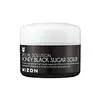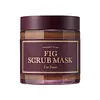What's inside
What's inside
 Key Ingredients
Key Ingredients

 Benefits
Benefits

 Concerns
Concerns

 Ingredients Side-by-side
Ingredients Side-by-side

Caprylic/Capric Triglyceride
MaskingBlack Strap Powder
HumectantPEG-7 Glyceryl Cocoate
EmulsifyingSucrose
HumectantGlycerin
HumectantCocos Nucifera Oil
MaskingDisteardimonium Hectorite
StabilisingButyrospermum Parkii Butter
Skin ConditioningEuphorbia Cerifera Wax
Water
Skin ConditioningPolysorbate 20
EmulsifyingPolyacrylate-13
Dextrin
AbsorbentTheobroma Cacao Extract
Skin ConditioningPolyisobutene
Limnanthes Alba Seed Oil
Skin ConditioningMangifera Indica Seed Butter
Skin ConditioningHelianthus Annuus Seed Oil
EmollientVitis Vinifera Seed Oil
EmollientEthylhexylglycerin
Skin ConditioningSorbitan Isostearate
EmulsifyingVegetable Oil
Skin ConditioningButylene Glycol
HumectantHoney Extract
HumectantCitrus Limon Fruit Extract
MaskingTocopherol
AntioxidantTbhq
Antioxidant1,2-Hexanediol
Skin ConditioningCamellia Sinensis Leaf Extract
AntimicrobialPhenoxyethanol
PreservativeParfum
MaskingCaprylic/Capric Triglyceride, Black Strap Powder, PEG-7 Glyceryl Cocoate, Sucrose, Glycerin, Cocos Nucifera Oil, Disteardimonium Hectorite, Butyrospermum Parkii Butter, Euphorbia Cerifera Wax, Water, Polysorbate 20, Polyacrylate-13, Dextrin, Theobroma Cacao Extract, Polyisobutene, Limnanthes Alba Seed Oil, Mangifera Indica Seed Butter, Helianthus Annuus Seed Oil, Vitis Vinifera Seed Oil, Ethylhexylglycerin, Sorbitan Isostearate, Vegetable Oil, Butylene Glycol, Honey Extract, Citrus Limon Fruit Extract, Tocopherol, Tbhq, 1,2-Hexanediol, Camellia Sinensis Leaf Extract, Phenoxyethanol, Parfum
 Reviews
Reviews

Ingredients Explained
These ingredients are found in both products.
Ingredients higher up in an ingredient list are typically present in a larger amount.
This ingredient is an emollient, solvent, and texture enhancer. It is considered a skin-softener by helping the skin prevent moisture loss.
It helps thicken a product's formula and makes it easier to spread by dissolving clumping compounds.
Caprylic Triglyceride is made by combining glycerin with coconut oil, forming a clear liquid.
While there is an assumption Caprylic Triglyceride can clog pores due to it being derived from coconut oil, there is no research supporting this.
Learn more about Caprylic/Capric TriglycerideParfum is a catch-all term for an ingredient or more that is used to give a scent to products.
Also called "fragrance", this ingredient can be a blend of hundreds of chemicals or plant oils. This means every product with "fragrance" or "parfum" in the ingredients list is a different mixture.
For instance, Habanolide is a proprietary trade name for a specific aroma chemical. When used as a fragrance ingredient in cosmetics, most aroma chemicals fall under the broad labeling category of “FRAGRANCE” or “PARFUM” according to EU and US regulations.
The term 'parfum' or 'fragrance' is not regulated in many countries. In many cases, it is up to the brand to define this term.
For instance, many brands choose to label themselves as "fragrance-free" because they are not using synthetic fragrances. However, their products may still contain ingredients such as essential oils that are considered a fragrance by INCI standards.
One example is Calendula flower extract. Calendula is an essential oil that still imparts a scent or 'fragrance'.
Depending on the blend, the ingredients in the mixture can cause allergies and sensitivities on the skin. Some ingredients that are known EU allergens include linalool and citronellol.
Parfum can also be used to mask or cover an unpleasant scent.
The bottom line is: not all fragrances/parfum/ingredients are created equally. If you are worried about fragrances, we recommend taking a closer look at an ingredient. And of course, we always recommend speaking with a professional.
Learn more about ParfumPeg-7 Glyceryl Cocoate is created from polyethylene glycol and fatty acids from coconut oil.
It is a synthetic polymer with emulsifying and cleansing properties.
As an emulsifier, Peg-7 Glyceryl Cocoate prevents ingredients such as oils and water from separating. It also helps rinse away oils, dirt, and pollutants from skin.
Peg-7 Glyceryl Cocoate may not be fungal acne safe. It can also dry out skin.
Learn more about PEG-7 Glyceryl CocoateSucrose is a natural sugar found in fruits, vegetables, and nuts. It is the main constituent of white sugar.
In skincare, sucrose is a humectant and can be a mild exfoliant.
Sucrose is hydrophilic, meaning it attracts water. This makes it an effective humectant and helps hydrate the skin.
Studies show sugars may worsen acne-prone skin due to it disrupting the skin's natural biome. We recommend speaking with a professional if you have any concerns.
In some products such as body scrubs, sucrose is used as an gentle exfoliant.
The term 'sucrose' comes from the french word for sugar, 'sucre'.
Learn more about SucroseEuphorbia Cerifera wax comes from a shrub in Northern Mexico. It is used to stabilize formulations and has emollient properties.
Emollients form a thin layer on top of skin to prevent water from evaporating, keeping skin and lips hydrated.
According to a manufacturer, this wax can range from a yellow/brown color to translucent.
Learn more about Euphorbia Cerifera Wax